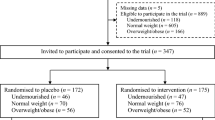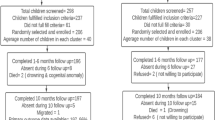Abstract
Background/Objectives:
Few studies have shown that supplementation with micronutrients (MNs) or n-3 fatty acids may have health benefits such as reduced morbidity in schoolchildren. The effect of a combination of these nutrients has never been investigated. This study aimed to determine the effect of a combination of two different doses of MN and n-3 fatty acids on morbidity in schoolchildren in Bangalore, India.
Subjects/Methods:
In all 598 children (6–10 years) received foods fortified with either high (100% recommended dietary allowance) or low (15% recommended dietary allowance) MN, combined with either high (900 mg α-linolenic acid (ALA) plus 100 mg docosahexaenoic acid) or low (140 mg ALA) n-3 fatty acids for 1 year. Morbidity was measured by weekly self-reports using a structured questionnaire. Poisson regression analyses of episodes/child/year and duration/episode adjusted for age and sex were performed on clusters of symptoms, including upper and lower respiratory tract infections (URTI and LRTI), gastrointestinal complaints (GI) and general symptoms of illness to observe MN and n-3 fatty acid treatment effects.
Results:
Children consuming high n-3 fatty acids had significantly fewer episodes of URTI/child/year (relative risk (RR)=0.88, 95% confidence interval (CI): 0.79, 0.97) and significantly shorter duration/episode of URTI (RR=0.81, 95% CI: 0.78, 0.85), LRTI (RR=0.91, 95% CI: 0.85, 0.97), GI complaints (RR=0.79, 95% CI: 0.74, 0.85) and general symptoms (RR=0.90, 95% CI: 0.82, 0.98) compared with children who received low n-3 fatty acid intervention. The high MN intervention reduced the duration of general symptoms (RR=0.89, 95% CI: 0.82, 0.98).
Conclusion:
Although n-3 fatty acids may be beneficial for reducing illness in Indian schoolchildren, more research is needed to confirm presence of combined effect with MN.
This is a preview of subscription content, access via your institution
Access options
Subscribe to this journal
Receive 12 print issues and online access
$259.00 per year
only $21.58 per issue
Buy this article
- Purchase on Springer Link
- Instant access to full article PDF
Prices may be subject to local taxes which are calculated during checkout

Similar content being viewed by others
References
Allen L, de Benoist B, Hurrell RF, Dary O (2006). Guidelines on Food Fortification with Micronutrients. World Health Organization and Food and Agriculture Organization of the United Nations: Geneva.
Allen LH, Peerson JM, Olney DK (2009). Provision of multiple rather than two or fewer micronutrients more effectively improves growth and other outcomes in micronutrient decient children and adults. J Nutr 139, 1022–1030.
Baqui AH, Zaman K, Persson LA, Arifeen SE, Yunus M, Begum N et al. (2003). Simultaneous weekly supplementation of iron and zinc is associated with lower morbidity due to diarrhea and acute lower respiratory infection in Bangladeshi Infants. J Nutr 133, 4150–4157.
Black RE (2003). Zinc deciency, infectious disease and mortality in the developing world. J Nutr 133, 1485S–1489S.
Brown KH, Rivera JA, Bhutta Z, Gibson RS, King JC, Lonnerdal B et al. (2004). International Zinc Nutrition Consultative Group (IZiNCG) technical document #1. Assessment of the risk of zinc deficiency in populations and options for its control. Food Nutr Bull 25, S99–S203.
Diaz JR, de las Cagigas A, Rodriguez R (2003). Micronutrient deficiencies in developing and affluent countries. Eur J Clin Nutr 57, S70–S72.
Eilander A, Hundscheid DC, Osendarp SJ, Transler C, Zock PL (2007). Effects of n-3 long chain polyunsaturated fatty acid supplementation on visual and cognitive development throughout childhood: a review of human studies. Prostaglandins Leukot Essent Fatty Acids 76, 189–203.
Galli C, Calder PC (2009). Effects of fat and fatty acid intake on inflammatory and immune responses: a critical review. Ann Nutr Metab 55, 123–139.
Hamazaki K, Syaffrudin D, Tunru IS, Azwir MF, Asih PB, Sawazaki S et al. (2008). The effects of docosahexanoinc acid-rich fish oil on behaviour, school attendance rate and malaria infection in school children—a double-blind, randomized, placebo-controlled trial in Lampung, Indonesia. Asia Pac J Clin Nutr 17, 258–263.
Imdad A, Herzer K, Mayo-Wilson E, Yakoob MY, Bhutta ZA (2010). Vitamin A supplementation for preventing morbidity and mortality in children from 6 months to 5 years of age. Cochrane Database Syst Rev 12, CD008524.
Kelly P, Katubulushi M, Todd J, Banda R, Yambayamba V, Fwoloshi M et al. (2008). Micronutrient supplementation has limited effects on intestinal infectious disease and mortality in a Zambian population of mixed HIV status: a cluster randomized trial. Am J Clin Nutr 88, 1010–1017.
Kris-Etherton PM, Innis S, American DA (2007). Dieticians of Canada. Position of the American dietetic association and dieticians of Canada: dietary fatty acids. J Am Diet Assoc 107, 1599–1611.
Lopriore C, Guidoum Y, Briend A, Branca F (2004). Spread fortified with vitamins and minerals induces catch-up growth and eradicates severe anemia in stunted refugee children aged 3–6 y. Am J Clin Nutr 80, 973–981.
Manger MS, McKenzie JE, Winichagoon P, Gray A, Chavasit V, Pongcharoen T et al. (2008). A micronutrient-fortified seasoning powder reduces morbidity and improves short-term cognitive function, but has no effect on anthropometric measures in primary school children in northeast Thailand: a randomized controlled trial. Am J Clin Nutr 87, 1715–1722.
Martinez M (1992). Tissue levels of polyunsaturated fatty acids during early human development. J Pediatr 120, S129–S138.
McCann JC, Ames BN (2005). Is docosahexaenoic acid, an n-3 long-chain polyunsaturated fatty acid, required for development of normal brain function? An overview of evidence from cognitive and behavioral tests in humans and animals. Am J Clin Nutr 82, 281–295.
Minns LM, Kerling EH, Neely MR, Sullivan DK, Wampler JL, Harris CL et al. (2010). Toddler formula supplemented with docosahexaenoic acid (DHA) improves DHA status and respiratory health in a randomized, double-blind, controlled trial of US children less than 3 years of age. PLEFA 82, 287–293.
Muthayya S, Dwarkanath P, Thomas T, Ramprakash S, Mehra R, Mhaskar A et al. (2009a). The effect of fish and omega-3 LCPUFA intake on low birth weight in Indian pregnant women. Eur J Clin Nutr 63, 340–346.
Muthayya S, Eilander A, Transler C, Thomas T, van der Knaap HC, Srinivasan K et al. (2009b). Effect of fortification with multiple micronutrients and n-3 fatty acids on growth and cognitive performance in Indian schoolchildren: the CHAMPION (Children's Health and Mental Performance Influenced by Optimal Nutrition) Study. Am J Clin Nutr 89, 1766–1775.
Muthayya S, Thankachan P, Zimmermann MB, Andersson M, Eilander A, Misquith D et al. (2007). Low anemia prevalence in school-aged children in Bangalore, South India: possible effect of school health initiatives. Eur J Clin Nutr 61, 865–869.
Penny ME, Marin RM, Duran A, Peerson JM, Lanata CF, Lönnerdal B et al. (2004). Randomized controlled trial of the effect of daily supplementation with zinc or multiple micronutrients on the morbidity, growth and micronutrient status of young Peruvian children. Am J Clin Nutr 79, 457–465.
Ramakrishnan U (2002). Prevalence of micronutrient malnutrition worldwide. Nutr Rev 60, S46–S52.
Ratnayake WM, Galli C (2009). Fat and fatty acid terminology, methods of analysis and fat digestion and metabolism: a background review paper. Ann Nutr Metab 55, 8–43.
Sarma KVR, Udaykumar P, Balakrishna N, Vijayaraghavan K, Sivakumar B (2006). Effect of micronutrient supplementation on health and nutritional status of school children: growth and morbidity. Nutrition 22, S8–S14.
Sazawal S, Black RE, Jalla S, Mazumdar S, Sinha A, Bhan MK (1998). Zinc supplementation reduces the incidence of acute lower respiratory infections in infants and preschool children: a double-blind, controlled trial. Pediatrics 102, 1–5. doi:10.1542/peds.102.1.1.
Sazawal S, Dhingra U, Dhingra P, Hiremath G, Kumar J, Sarkar A et al. (2007). Effects of fortified milk on morbidity in young children in north India: community based, randomised, double masked placebo controlled trial. BMJ 334, 140. doi:10.1136/bmj.39035.482396.55.
Serhan CN, Hong S, Gronert K, Colgan SP, Devchand PR, Mirick G et al. (2002). Resolvins: a family of bioactive products of omega-3 fatty acid transformation circuits initiated by aspirin treatment that counter proinflammation signals. J Exp Med 196, 1025–1037.
Sharieff W, Bhutta Z, Schauer C, Tomlinson G, Zlotkin S (2006). Micronutrients (including zinc) reduce diarrhoea in children: the Pakistan Sprinkles Diarrhoea Study. Arch Dis Child 91, 573–579.
Singh V, West Jr KP (2004). Vitamin A deficiency and xerophthalmia among school-aged children in Southeastern Asia. Eur J Clin Nutr 58, 1342–1349.
Smuts CM, Lombard CJ, Benadé AJ, Dhansay MA, Berger J, Hop le T et al. (2005). International Research on Infant Supplementation (IRIS) Study Group. Efficacy of a foodlet-based multiple micronutrient supplement for preventing growth faltering, anemia, and micronutrient deficiency of infants: the four country IRIS trial pooled data analysis. J Nutr 135, 631S–638S.
Srihari G, Eilander A, Muthayya S, Kurpad AV, Seshadri S (2007). Nutritional status of affluent Indian school children: what and how much do we know? Indian Pediatr 44, 204–213.
Thienprasert A, Samuhaseneetoo S, Popplestone K, West AL, Miles EA, Calder PC (2009). Fish oil n-3 polyunsaturated fatty acids selectively affect plasma cytokines and decrease illness in Thai schoolchildren: A randomized, double-blind, placebo-controlled intervention trial. J Pediatr 154, 391–395.
Tull SP, Yates CM, Maskrey BH, O’Donnell VB, Madden J, Grimble RF et al. (2009). Omega-3 Fatty acids and inflammation: novel interactions reveal a new step in neutrophil recruitment. PLoS Biol 7, e1000177.
Uauy R, Castillo C (2003). Lipid requirements of infants: implications for nutrient composition of fortified complimentary foods. J Nutr 133, 2962S–2972S.
van Stuijvenberg ME, Kvalsvig JD, Faber M, Kruger M, Kenoyer DG, Benadé AJS (1999). Effect of iron-, iodine-, and b-carotene–fortified biscuits on the micronutrient status of primary school children: a randomized controlled trial. Am J Clin Nutr 69, 497–503.
Vaz M, Pauline M, Unni US, Parikh P, Thomas T, Bharathi AV et al. A double blind randomized controlled trial to evaluate the impact of a multiple micronutrient fortified nutritional supplement on physical performance measures among school children, in South India. J Nutr (in press).
Weaver KL, Ivester P, Seeds M, Case LD, Arm JP, Chilton FH (2009). Effect of dietary fatty acids on inflammatory gene expression in healthy humans. J Biol Chem 284, 15400–15407.
Acknowledgements
We are most grateful to the principals and teachers of the schools, the children and their parents for their participation in the study. We thank all our colleagues from St John's Research Institute and Unilever who were involved in preparation and execution of the study. All authors read and approved the final manuscript. This research was supported by Unilever Netherlands BV.
Author information
Authors and Affiliations
Corresponding author
Ethics declarations
Competing interests
A Eilander, S McKay, W Theis and S Osendarp are employees of Unilever. AV Kurpad is a member of the Kraft Health and Wellness Advisory Council. T Thomas, S Muthayya, P Thankachan and A Gandhe declare no conflict of interest.
Rights and permissions
About this article
Cite this article
Thomas, T., Eilander, A., Muthayya, S. et al. The effect of a 1-year multiple micronutrient or n-3 fatty acid fortified food intervention on morbidity in Indian school children. Eur J Clin Nutr 66, 452–458 (2012). https://doi.org/10.1038/ejcn.2011.178
Received:
Revised:
Accepted:
Published:
Issue Date:
DOI: https://doi.org/10.1038/ejcn.2011.178
Keywords
This article is cited by
-
Do healthy school meals affect illness, allergies and school attendance in 8- to 11-year-old children? A cluster-randomised controlled study
European Journal of Clinical Nutrition (2015)
-
Infants fed formula with added long chain polyunsaturated fatty acids have reduced incidence of respiratory illnesses and diarrhea during the first year of life
BMC Pediatrics (2014)



